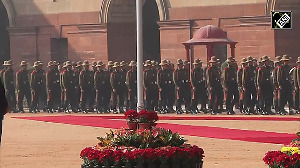'While my generation carries with it the memory of the Chinese perfidy of 1962, this generation will carry the memory of Chinese perfidy in Galwan.'

"India must assess the potential national security risks associated with reliance on Chinese technology and products. This includes scrutinising telecommunications and critical infrastructure sectors where Chinese companies have a significant presence," says retired Lieutenant General Gautam Moorthy, founder, managing director of Current and Strategic Affairs Forum, a virtual think-tank.
General Moorthy served the Indian Army for 39 years. He was former Director General, Army Ordnance Corps and administrative member, Armed Forces Tribunal.
"Increased scrutiny of Chinese investments in Indian companies is crucial. This includes evaluating potential security implications of FDI from China, especially in sensitive sectors," the general says in the concluding part of his interview to Rediff.com's Archana Masih.
- Part 1 of the Interview: 'Always Treat China With Caution'
Does the breakthrough in Depsang and Demchok open up a path for a resolution of the stand-off in Yangtse, Asaphila and Subansiri?
Yes, there were reports of stand-offs between the Indian Army and the People's Liberation Army in the Yangtse, Asaphila and Subansiri areas. These areas became have become focal points of tension following some face-offs after 2020.
However, there are no reported incursions in these areas. The Indian Army remains deployed along our border in these areas. It is too early to comment on this as of now.
The Special Representatives on the boundary issues who have not met since 2019 are expected to meet soon.
Can this thaw between the two countries pave the way towards some resolution of the boundary dispute?
The 'boundary dispute' you are referring to is referred to by both countries as the 'boundary question'.
It is not seen as a dispute per se, as some commentators call it, but it is an issue that needs to be resolved by talks between the two nations.
These discussions are a crucial diplomatic mechanism aimed at addressing various issues that have arisen due to territorial disagreements, particularly along the Line of Actual Control.
The last Special Representative Talks (22nd), between India and China were held in December 2019 with the Indian delegation being headed by our National Security Advisor Ajit Doval and the Chinese one by their Minister of Foreign Affairs Wang Yi.
Apart from the boundary question, it includes a strategic dialogue and discussions on confidence building measures. The talks aim at enhancing bilateral relations.
Yes, I am sanguine that the 23rd Special Representative Talks will be held shortly, but not before the military issues along the LAC have made good progress.

It will be yet another winter where our troops will continue to be deployed in extreme conditions -- realistically speaking how long would it take for PLA permanent structures to be dismantled, de-escalation and troop withdrawal?
There are three stages to this entire process. The first stage is dis-engagement. This is what is going on now.
The next will be de-escalation and finally, de-induction.
As we are aware, winter is already setting in. The troops deployed there are well equipped and housed. Stocks of food, clothing, equipment, fuel, ammunition and stores would have already been made up to the maximum quantities/ numbers authorised as per the advance winter stocking schedule.
So, while the entire process may take time, the troops there would not be short of any essential commodity.
That said, our de-induction will be taking place at the same pace as the Chinese de-induction. In fact, you would recall that our deployments post Galwan mirrored the PLA deployment.
So, the reverse process will begin and would be conducted simultaneously by the two armies.

What did China gain by the Galwan clash and conflict?
I don't really know what China gained, but China certainly lost the trust of 1.4 billion Indians of whom our youth is about 65 million.
While my generation carries with it the memory of the Chinese perfidy of 1962, this generation will carry with it the memory of Chinese perfidy in Galwan that too at a time when a Chinese origin virus was sweeping across India and the globe causing untold misery.
That apart, the Chinese intrusion in Eastern Ladakh showed the world and China's neighbours what China was capable of and made them wary of China.
It was also a wake-up call to our own defence planners that we must continue to push our capability building, capacity enhancement and infrastructure development in our border areas.
To my mind, winning back the trust amongst the Indian people based on the understanding reached at Kazan will take a long time.

What caution should India follow in terms of its conduct of trade with China, especially in terms of the security dimension?
Trade with China is booming despite the setbacks on the political, diplomatic and the military fronts. Following the initial downturn, imports began to recover. By 2021, India's imports from China rebounded significantly, reaching levels that surpassed pre-pandemic figures. In the fiscal year 2021-2022, for instance, imports from China were approximately $97 billion.
In 2023-2024, India's exports to China were $16.65 billion and its imports from China in 2023-2024 were $101.74 billion. The total trade between India and China in 2023-2024 was $118.4 billion. China is India's largest trading partner.
The key cautions India must exercise in its trade with China are as follows:
- National Security Risks: India must assess the potential national security risks associated with reliance on Chinese technology and products. This includes scrutinising telecommunications and critical infrastructure sectors where Chinese companies have a significant presence.
- Supply Chain Vulnerabilities: Diversifying supply chains is essential to reduce dependency on China. India should seek to develop alternative sources for critical goods and raw materials to mitigate risks from geopolitical tensions or disruptions. We must be wary of supply chain infections -- cyberattacks that use a third-party vendor to gain access to our systems or data.
- Investment Scrutiny: Increased scrutiny of Chinese investments in Indian companies is crucial. This includes evaluating potential security implications of foreign direct investment (FDI) from China, especially in sensitive sectors.
- Strategic Sectors Focus: We must truly aim at achieving Atmanirbharta. We must prioritise self-reliance in strategic sectors such as defence, pharmaceuticals, and technology. This can help reduce our vulnerabilities. India should invest in domestic production capabilities to lessen dependence on imports from China.
- Trade Agreements and Partnerships: Engaging in trade agreements with other countries can help India build a more resilient and robust economic framework. Strengthening ties with nations that share similar security concerns can provide alternative markets and sources of goods.
- Monitoring Dual-Use Technologies: India should be vigilant about imports that could have dual-use applications (civilian and military). This includes technologies that could be repurposed for military use, necessitating careful evaluation before procurement.
- Finally, India has to address this growing trade deficit and lean less on China.
Feature Presentation: Aslam Hunani/Rediff.com










